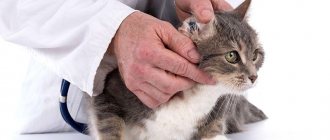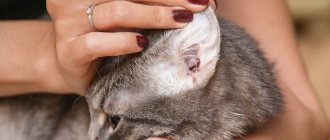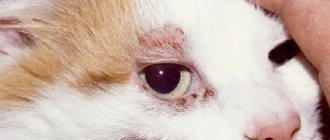Ear mites in cats are a disease that many owners of furry creatures have had to deal with. The cause of the disease in your pet is a tiny arthropod. Suction of blood, as well as its waste products, cause inflammation of the auricle and excessive production of wax. As a result, the cat experiences severe discomfort and malaise. Therefore, every caring owner of a four-legged friend should know how to treat ear mites in their pet.
What does an ear mite look like in cats?
In cats, ear mites cause inflammation of the outer ear (otitis) of parasitic origin.
Species and life cycle stages
The causative agent is the ear mite - Otodectes cynotis, which belongs to the group of acariform mites. It has an elliptical body shape, suckers on unsegmented legs and a gnawing type mouthparts. The tick feeds on the outer layer of the epithelium - the epidermis, as well as tissue fluid. Males have four pairs of paws, while in females the fourth pair is underdeveloped. The dimensions of the ear mite are from 0.3 to 0.7 mm in length and from 0.47 to 0.55 mm in width. Females are slightly larger than males. During her life, each female is capable of laying several hundred eggs, maintaining the course of the disease. On average, the development cycle of a tick is 21 days:
- After 4 days, a larva emerges from the egg, which after 3–12 days of active feeding becomes a protonymph.
- After molting, the protonymph transforms into a deutonymph.
- After the next molt, the deutonymph becomes the adult form of the parasite - the imago; Female ear mites begin to reproduce already at the deutonymph stage.
In the development cycle, the ear mite goes through an egg stage, a larvae, and two nymph stages before becoming an adult form - an adult.
They can survive in the environment at room temperature for up to 12 weeks; boiling kills them instantly.
Can it be seen with the naked eye?
Given the small size of the pathogen, it is very difficult to see it with the naked eye. In some cases, if the mites are large enough, they can be seen if you put infected earwax on black paper. Mites look like very small whitish dots, about half the size of a semolina grain, spreading across the paper. It is not possible to identify the pathogen in this way, so the diagnosis is made based on laboratory research methods.
Time of greatest activity
Ear mites are active all year round, but cats are infected somewhat more often in the summer. Apparently, this is due to the fact that in summer the pathogen is able to persist longer in the external environment.
Danger to humans
Ear mites do not parasitize humans. But in some people, the causative agent of otodectosis, carried from the ears of a cat to human skin, can cause an allergic reaction in the form of a rash consisting of papules (tubercles), accompanied by redness and itching of the skin. Once on human skin, the pathogen quickly dies and does not pose a risk of infection.
The ear mite has an oval body shape and a gnawing mouthpart.
What procedures provoke an exacerbation?
Even after treatment, the skin is vulnerable to external influences, not to mention skin that has not undergone therapy, since its protective functions are significantly reduced. As noted earlier, other exacerbation factors include some cosmetic procedures:
- phototherapy and laser coagulation - these procedures help to increase temperature and increase blood flow to the skin, and at the same time increase the production of sebum (and this is simply an ideal environment for subcutaneous mites);
- massages, vaporization, ultraviolet exposure (in a solarium, for example) - also contribute to increased sebum production, and therefore should be excluded from the list of procedures until remission is achieved;
- chemical peeling - in the acute stage of the disease, aggressive acids only contribute to the proliferation of mites, however, this procedure is sometimes effective in combating residual effects on the skin (everything is very individual);
- Skin biorevitalization is one of the most popular anti-aging procedures, but during periods of exacerbation of the disease it is contraindicated.
How do cats become infected with ear mites?
The reservoir of otodectosis is cats and dogs infected with it, mostly stray ones. Among pets, rabbits and ferrets may be infected with otodectosis.
Cats become infected with ear mites:
- in direct contact with a sick animal, especially free-ranging cats;
- in some cases, fleas become carriers of ear mite eggs;
- when cats are kept in a crowded environment, infection is possible through common care items: bedding;
- toys;
- grooming tools;
- carrier bags;
The disease is highly contagious and affects cats of all ages. The most susceptible are young pets aged 1.5 to 6 months.
Infection of pets most often occurs through contact with sick stray pets.
Where can you get infected?
Let's now look at where a cat can become infected with this mite.
- Option #1. If you bought a kitten, and it complains about its ears, then in this case the infection occurred from its mother, the cat.
- Option #2. If your pet left the house, even for 5 minutes. He went out to the entrance, went to the dacha, exhibition, mating, etc.
- Option #3. You picked up a stray animal and brought it home for a while, even for 5 minutes, and you already have a cat. This is also enough for your pet to receive a portion of ticks.
- Option number 4. There are 2 cats living in the house, one has constant problems with her ears, and the other is fine. This suggests that there is a hidden carrier in your family, i.e. He doesn’t get sick himself, but he constantly infects others. Can you guess who it is? Yes, it is the cat that does not complain about its ears that is the hidden carrier of the tick.
Symptoms of otodectosis
Otodectosis in most cases affects the inner surface of the auricle, the external auditory canal and the eardrum. A small number of ticks can also be found on other parts of the pet’s body:
- on the neck;
- in the area of the sacrum;
- on the tail.
The spread of the pathogen occurs when the cat sleeps curled up in a ball.
Symptoms of otodectosis include:
- finding a large amount of brown, brown or almost black earwax in the external auditory canal, which looks very similar to ground coffee;
- scratching on the cat's ears;
- animal anxiety;
- itching in the area of the infected ear, the cat scratches the ear with its paws, and also tries to scratch it on surrounding objects;
- the presence, in addition to brown wax, of discharge from the ears, the nature of which changes from serous at the beginning of the disease to purulent with its further development. Otodectosis is complicated by the addition of bacterial or fungal flora. The discharge gives earwax a putty-like consistency. Ear mites die in the acidic environment of the inflammatory exudate, which makes it difficult to detect living mites under microscopy. Skin itching decreases, but symptoms of inflammation increase and the cat’s condition worsens;
- the presence of scabs in and around the affected ear;
- gradual deterioration of hearing, possible loss of hearing;
- possible fever;
- tilting the head downwards with the affected ear - this indicates the spread of the process to the eardrum, middle and inner ear;
- convulsions - occur with advanced disease, when the process spreads to the meninges.
Photo gallery: symptoms of otodectosis
With odecosis, secretions and inflammatory exudate accumulate in the external auditory canal; the skin may be damaged by scratching
With odecosis, discharge from the ears is profuse and dark in color.
Trying to get rid of severe itching, the cat intensively scratches its ears, which leads to skin damage.
How to treat
After confirming the diagnosis, it is necessary to immediately begin its treatment. The pathology causes discomfort to the animal and progresses rapidly.
Therapy for otodectosis is carried out in several directions. Here is their list:
- ear cleansing;
- use of antiparasitic drugs;
- increasing general immunity.
Ear treatment
When performing this manipulation, it is better not to use cotton swabs, because there is a high risk of injury to the ear canal. Also, you can accidentally push the secretions deeper.
Processing is carried out according to the following algorithm:
- The ears are cleared of plaque accumulations. This allows you to reduce the number of parasites and secondary microbial flora. Regular vegetable oil or special solutions (Fitolar, Otoklin, Otifri) are used.
- Apply drops or ointment in the amount specified in the instructions.
- Massage the ears to distribute the medication evenly.
- Wiping the ears with a cotton pad soaked in a medicinal product.
Drugs
There is a wide range of medications designed to get rid of ear mites in cats. They are available in the form of drops, ointments, aerosols, suspensions, tablets and injections. The veterinarian selects the best option for each specific case. It takes into account several factors:
- pet's age;
- presence or absence of concomitant infections;
- degree of damage.
The most common drugs:
- Dekta;
- Aurikan;
- Demos;
- Ectodes;
- Surolan;
- Aversectin ointment;
- Otoferonol Gold;
- Amidel;
- Oricin;
- Ivermek;
- Avertel;
- Otodectin.
If the case is advanced, the specialist always prescribes antibiotics or injections.
Depending on the severity of the pathology, treatment lasts from two weeks or longer. In difficult cases, therapy continues for several weeks or even months.
Strengthening your immune system means establishing a balanced diet. If necessary, it is worth adding vitamins for cats or immunomodulators (for example, Fosprenil).
Folk remedies
The use of traditional methods is allowed only at the very beginning of the disease. If the symptoms are pronounced, then this can only be an auxiliary treatment. Main methods:
- Hydrogen peroxide. For wiping the surface of cartilage and wetting crusts.
- Garlic juice or pulp. It is highly irritating, so you need to use it carefully.
- Juice from leaves or stems of celandine.
- Vegetable oils (sea buckthorn, olive and others). They soften scabs well and help remove them.
- Green tea. A strong infusion has antiseptic properties and helps reduce inflammation.
Diagnosis of otodectosis
To make a diagnosis, the veterinarian examines the cat and asks the owner about the onset and development of the disease. Additional research methods are carried out to verify the diagnosis and, if necessary, to clarify the extent of the process:
- microscopy of earwax and scrapings from the ear is performed. Under a microscope, living mites at different stages of development are visible, and you can also determine the type of secondary flora that has attached;
- bacteriological examination - if necessary, to accurately identify the secondary flora, cultures are carried out on nutrient media;
- otoscopy - performed to assess the condition of the external auditory canal and eardrum. In case of severe inflammation of the external auditory canal, otoscopy is abstained until the inflammation decreases;
- computed tomography or magnetic resonance imaging - performed when the infectious process spreads to the middle ear, inner ear, or meninges.
To more accurately assess the distal part of the external auditory canal, as well as the eardrum, veterinarians perform otoscopy
Treatment of otodectosis
In the vast majority of cases, treatment of otodectosis is carried out at home, with the exception of those situations where the inner ear and meninges are affected, in these cases surgical treatment is carried out in a hospital setting.
When treating otodectosis, we are guided by the following principles:
- treatment of secondary bacterial or fungal inflammation to reduce pain and itching. For this purpose, the following are used: antibacterial agents;
- antifungal drugs;
- anti-inflammatory drugs;
- allows you to reduce the number of ear mites and secondary microbial flora;
Only a veterinarian can prescribe medications for the treatment of otodectosis.
Drug therapy for otodectosis
For drug treatment of otodectosis, the following is used:
- acaricidal drugs: ear drops: Amitrazine;
- Aurikan;
- Neostomozan;
- Tsipam;
- Surolan.
- Ivermek-gel;
- Frontline;
- Aversect;
- Sinulox;
- Clotrimazole ointment;
- Suprastin;
- Gamavit;
- Katozal;
Photo gallery: medicines for the treatment of otodectosis
Amidel-gel has, in addition to acaricidal, also an analgesic effect
Stronghold drops are applied to the skin of the withers; In order for it to work, it is not necessary to clean the ear, which is important for severe inflammation of the external auditory canal
Aurikan drops have acaricidal, analgesic, anti-inflammatory and antiseptic effects
Table: medications used to treat otodectosis
| A drug | Compound | Operating principle | Price, rub |
| Doxycycline | Doxycycline | A broad-spectrum antibacterial drug prescribed for complicated forms of otodectosis. Not for use in pregnant and lactating cats; in kittens during the period of teeth change; with decompensation of liver and kidney function, in exhausted pets | from 23 |
| Stronghold | Selamectin | Drops for application to the skin. They have anthelmintic, acaricidal, and insecticidal effects. If necessary, re-treatment is carried out after a month. Not for use in kittens under 6 weeks of age, as well as in sick and weakened animals. Not inserted directly into the ear canal. Can be used in pregnant cats | from 285 per pipette |
| Frontline Spot-on | Fipronil | Drops for application to the skin. They have insecticidal and acaricidal effects. 4-6 drops are instilled into each ear, and the remaining product is applied to the skin between the shoulder blades. After 3 weeks, the treatment is repeated. You cannot wash your cat for 2 days after treatment. Approved for use in pregnant and lactating cats. Not used in kittens under 2 months of age - Frontline spray is used for very young kittens | from 370 |
| Amidel-gel Neo |
| Gel for topical use. It has an acaricidal effect, lidocaine reduces pain, chloramphenicol is an antiseptic. The product is evenly applied to the affected areas after cleansing, covering 1 cm of healthy skin. The drug is used 2 to 5 times with an interval of 5–7 days. Not for use in pregnant cats or kittens under 4 weeks of age. | 195 |
| Aurikan |
| Ear drops. They have acaricidal, antiseptic, anti-inflammatory and analgesic effects. The drug is instilled 5 drops into each ear once a day for a week, then twice a week for a month. Data on use in kittens and pregnant cats are not provided in the instructions. | 579 |
| Otodectin | Ivermectin | Solution for subcutaneous injection. It has acaricidal, anthelmintic and insecticidal effects. Apply twice with an interval of 10 days. Not for use in kittens under two months of age; There are no data on use in pregnant cats in the instructions. | 621 |
| Tavegil | Clemastine | An antihistamine used to eliminate the symptoms of allergic dermatitis, which can cause otodectosis. Not for use in pregnant cats | from 159 |
Video: otodectosis in pets
Traditional medicine in the treatment of otodectosis
Traditional medicine is significantly inferior in effectiveness to medications, and is worthy of attention in cases where the cat needs help, but the drugs prescribed by the doctor have not yet been brought from the pharmacy. Modern acaricides can be used in both pregnant cats and kittens. In addition, to completely cure a cat, it is necessary to exterminate all ticks, including those on other parts of the body, which cannot be achieved using only traditional methods. To treat otodectosis in cats using folk remedies:
- Ointment with sulfur and potassium carbonate based on lard:
- Take 20 g of rendered lard without salt.
- Add 8 g potassium carbonate.
- Add 15 g of colloidal sulfur.
- Mix well until the ointment has a homogeneous consistency.
- Apply the resulting product to the skin of the external auditory canal and auricle 2-3 times a day until symptoms disappear completely.
- An infusion of strong green tea is used to wipe a cat’s ears to reduce inflammation.
How to properly clean a cat's ears
In advanced cases of otodectosis, inflammation in the ears can be so severe that the slightest touch to the skin of the ear causes damage to the inflamed epithelium and the formation of a hardened surface. The cat behaves aggressively, cleaning its ears is painful for it. Therefore, ears are not cleaned in such cases. Treatment begins with acaricidal drugs such as Stronghold or Frontline, which are applied to the skin of the withers; antibacterial agents are also used, for example, Sinulox, in tablets or injections. These products realize their effect by acting systemically, and they return to cleaning the ears and using drugs for local therapy when the symptoms of inflammation decrease and cleaning the ears does not result in additional injuries to the inflamed skin and the suffering of the cat.
Even if a cat tolerated ear cleaning before illness, it will resist when trying to clean sore ears. In order to clean the cat's ears, it is better to swaddle it with a towel and use the help of an assistant who will hold the cat. In the absence of an assistant:
- Prepare all the necessary ear cleaning products and wipes and place them nearby.
- Swaddle the cat in a towel and place it on your lap; this will make it easier to limit its mobility using your elbows and body.
- Open the cat's ear and assess the condition of the skin on the inner surface of the auricle and the visible part of the external auditory canal.
- With a napkin moistened with hygienic lotion for cleaning the ears or an aqueous solution of chlorhexidine, wipe the inside of the auricle and the visible part of the external auditory canal.
- After cleaning the skin, remove excess lotion or antiseptic with a dry cloth.
- Depending on the prescribed remedy, the following is carried out:
- instillation of drops;
- applying gel or ointment, they are distributed over the surface of the ear with a napkin;
- aerosol spraying.
- The cat's ear is folded in half and gently massaged at the base, promoting uniform distribution of the drug.
- Wipe the outer surface of the ear and the areas of fur around it with a napkin soaked in this preparation.
- Repeat all the steps performed with the second ear, even if it looks healthy. Use other wipes to prevent the transfer of ticks.
- Put a protective collar on the cat to prevent self-harm and release it.
- Collect all used napkins contaminated with mites, place them in a plastic bag, tie them tightly and throw them away. If possible, it is better to burn it.
Ear cleaning during otodectosis is carried out 2 times a day, when signs of inflammation subside - daily, until complete recovery.
In order to protect yourself from the cat’s claws, as well as limit its mobility, before cleaning your pet’s ears, you need to swaddle it with a towel.
Folk remedies
Traditional methods of treating otodectosis
A more gentle way to treat a cat is to use traditional folk remedies. They can be used either alone or in combination with medicinal ointment, drops or spray.
- Celandine, or rather its juice, is effective against ticks. To prepare it, use the stems and leaves of the plant, which are passed through a meat grinder. The resulting mixture is squeezed out and used for instillation into the ears (2 drops 2 times a day).
- Garlic. The vegetable, known to everyone for its antiseptic properties, is also used to remove ticks. The raw materials are crushed and filled with almond, olive or sunflower oil. After 24 hours, the mixture is filtered and instilled into both ears, 2 drops once a day.
- Green tea also has equally effective anti-inflammatory properties. A strong brew of it is placed in the ears of an infected animal at least 3 times a day.
- Iodine-glycerin infusion. To treat a cat's ears, you can use a solution prepared from iodine and glycerin, taken in a ratio of 1:4. Treatment with the composition is carried out once a day.
On a note!
You should not replace the use of pharmaceutical remedies with folk remedies if your cat is highly infested with ear mites.
Why is an integrated approach to treating your pet important?
Compliance with all measures prescribed by a veterinarian is necessary to achieve a speedy recovery, as well as to prevent re-infection. It is extremely important to combine local acaricidal agents with agents applied to the withers in the form of drops, since if all ticks are not destroyed, the disease will return. The use of antibacterial and antifungal drugs is important because the accompanying bacterial or fungal otitis media poses a risk to the cat's health. Desensitizing agents prescribed by a veterinarian effectively stop allergic inflammation that otodectosis causes in some cats and prevent the development of complications associated with it. The recovery of pets with an advanced form of the disease, as well as elderly and weakened cats, can be accelerated by immunomodulators and agents that improve metabolism.
Video: treatment of otodectosis in pets
Forecasts
Animals infected with ear mites respond well to treatment. In mild form, relief occurs within 2-3 days after the start of treatment. In advanced cases, repeated treatment is required and the recovery period directly depends on the degree of infection of the animal. On average, treatment lasts 2-4 weeks with repeated treatments.
In the most difficult cases, trauma to the animal's eardrum, otitis media, is possible. In this case, treatment must be carried out under the supervision of a veterinarian with a systematic examination of the healing of the eardrum (otoscopy). The prognosis in this case is individual for each patient; lifelong deafness is possible.
Possible complications of otodectosis
Complications of otodectosis include:
- bacterial or fungal otitis - are the most common complications of otodectosis;
- hematomas and lymphatic extravasations of the auricle are also common, are the result of self-harm and require the participation of a veterinarian. Hematomas are formed when a blood vessel is damaged, lymphatic extravasates - when a lymphatic vessel is damaged by a cat’s claws. In this case, an accumulation of blood or lymph occurs in the tissues of the ear, which requires opening and draining the resulting cavity with evacuation of its contents. Otherwise, suppuration will occur, which will result in permanent scar deformation of the ear. The opening and drainage of the hematoma or lymphatic extravasation is performed by a veterinarian;
- miliary dermatitis (eczema) - develops in some cats because mite saliva and feces are strong allergens. At the same time, numerous bubbles appear in the ear area, which, when opened, turn into erosions covered with dry crusts. This increases inflammation, pain and skin itching, significantly worsening the cat’s condition;
- perforation of the eardrum and the development of otitis media and internal otitis: leads to decreased hearing up to its complete loss, but with a small hole size and proper treatment, the membrane is quickly restored;
- leads to the appearance of peripheral vestibulopathy, while: the coordination of movements in the cat is impaired;
- Characteristic is a lateral tilt of the head, the affected ear facing downwards;
- the cat can move in a circle;
- Nausea may occur when moving;
- strabismus occurs.
- extremely serious condition of the cat;
Ear hematoma often occurs during otodectosis as a result of self-injury; opening and emptying of hematomas is carried out by a doctor in a veterinary clinic
Causes of exacerbation of demodicosis
- various types of dermatitis;
- weakened immune system;
- acne;
- skin infections;
- HIV;
- gastrointestinal diseases.
To treat the disease, you must consult a doctor. Self-medication in this case is evil. The doctor will conduct an appropriate study and prescribe adequate therapy.
Otodectosis in kittens
Kittens are very susceptible to otodectosis, so they need regular monitoring of the condition of their ears and timely contact with a veterinarian if they suspect the development of otodectosis. When treating kittens, they are guided by the principles applicable in the treatment of adult cats, using medications taking into account the restrictions associated with the age of the kitten.
In kittens up to 4 months old, an extremely severe atypical form of otodectosis can occur, which manifests itself:
- the kitten shakes its head;
- seizures occur, including long-term ones (up to 10 minutes);
- the onset of sudden death.
Prevention of otodectosis
Measures to prevent otodectosis:
- preventive treatment with acaricidal drugs, which are often included in drugs that prevent the appearance of fleas;
- preventing cat contact with stray animals;
- regular monitoring of the condition of the cat’s ears;
- when introducing a new pet, especially one taken from the street, into an established cat community, you need to make sure that it does not have otodectosis;
- regular wet cleaning of the premises where cats are kept;
- steam treatment of beds and soft toys, regular washing of bedding;
- avoiding overcrowding when keeping cats.
If one of the cats living in the house becomes ill with otodectosis, then all pets must be treated, since otodectosis is a highly contagious disease.
Otodectosis: its danger and causes
Often, cat owners do not pay attention to the onset of the development of otodectosis, ignoring the symptoms, or do not fully understand the danger of this disease in their pets. Ear scabies is serious because the skin in the ears is affected, and the mite penetrates the entire ear canal right up to the eardrum. Its perforation is fraught with deafness, and the transition of the inflammatory process to the membranes of the brain destroys it, and, as a result, death.
The mite Otodectes cynotis feeds on living and dead epithelial cells, and otodectosis develops very quickly. The tick lives on the host's body for up to 25 days, the life cycle of the parasite is 3-4 weeks.
Causes of the disease:
- direct contact of a healthy cat with an animal that has otodectosis. It is not necessary that this is also a cat - the tick feels equally comfortable on dogs, rodents, rabbits, foxes, etc.;
- contact of a cat with surfaces on which eggs or mature ticks have fallen;
- The owner himself becomes the source of pathology, transferring scales of infected epidermis with secretions from a sick animal to a healthy one.
The last point is especially relevant for those who believe that a cat living in an apartment and having no contact with the outside world cannot get otodectosis. Maybe, like flea dermatitis and viral pathologies, all diseases that are easily transmitted by contact and the pathogen persists for a long time in environmental conditions.










